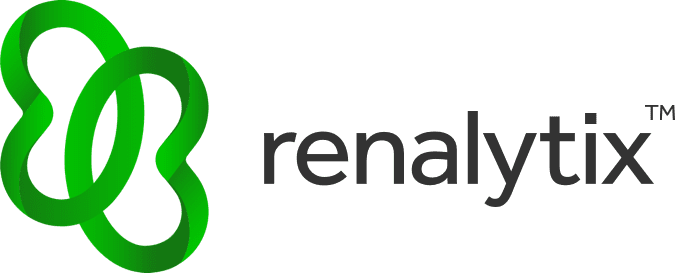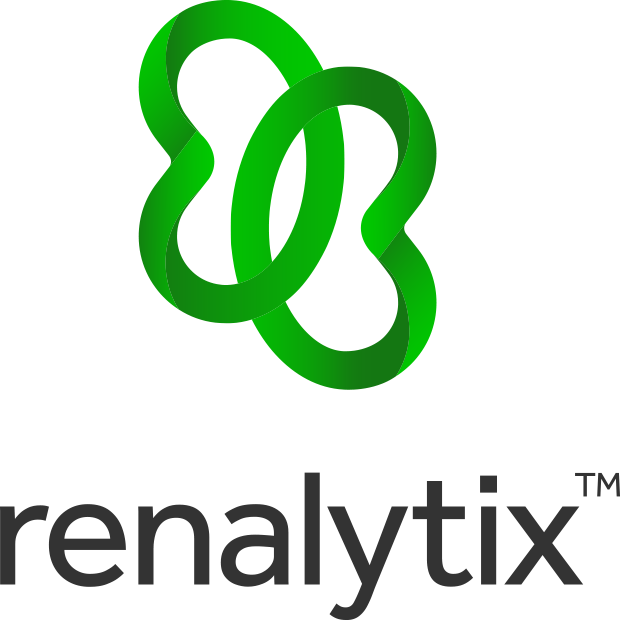3 Ways We’re Translating Lessons Learned in Cancer to Help Fix the Kidney Care Model
By Elise Wilfinger
07.27.2021

“That’s why I joined forces with James (James McCullough, CEO & Board Member), Michael (Michael Donovan, Chief Medical Officer), Fergus (Fergus Fleming, Chief Technology Officer) and leading nephrologists (Steve Coca, Girish Nadkarni). And why we’ve been fortunate to work with institutions – Mt Sinai, Harvard and Joslin Diabetes Center – in the formulation and early growth stages of Renalytix.
We knew that we could bring our learning from working in the cancer field – our understanding of diagnostics, precision medicine and how both prognosis and outcomes can be changed in cancer – to help fix the issues in the kidney disease care model in the U.S. and around the world.”
Tom McLain, President, Renalytix
Former CEO, Exosome Diagnostics
Former CEO & President, Vermillion, Inc.
Introduction
For decades, a cancer diagnosis was a death sentence. But, with ambitious goals, advances in earlier detection and prevention and novel therapeutics, many Cancers are now treatable as a chronic condition. Still others can be cured.
In 2019, the American Cancer Society made the remarkable announcement that the cancer death rate had dropped 27% in 25 years1.
Furthermore, it estimated that there are more than 17 million cancer survivors in the US today, and that this number would likely grow to 22+ million by 20302.
For a very long time, doctors, researchers and patients alike, would never have believed such positive statistics and trends were possible.
Our premise: if it can be done for cancer, it can be done for kidney disease.
Here’s how we’re embracing moonshot thinking to translate lessons learned from working in the cancer field to actionable steps toward eradicating kidney disease.
1. The earlier the better.
Learnings from Cancer care:
When cancer is diagnosed early, it likely hasn’t had the chance to spread and metastasize. In this case, patients have their best chance for successful treatment and improved quality of life. Conversely, when the care is delayed, there is a reduced chance of survival, a potential for more treatment-associated problems, and ultimately, a higher cost burden for the patient, health care system and insurance providers. This, of course, varies based on the type of cancer.
Across the globe, there is much documented evidence that catching various cancers in earlier stages yields much better results.
In the U.S., trends in 5-year relative survival rates have been quite striking among all races, comparing the years of 1975-77 to 2010-2016, as found in Table 7 of the American Cancer Society, Cancer Facts & Figures 2021. Change in results has been somewhat attributed to improved awareness of symptoms and earlier detection.
- Breast cancer: 75% to 90% survival
- Colon cancer: 51% to 63% survival
- Ovarian cancer: 36% to 49% survival
- Prostate cancer: 68% to 98% survival
Here are some similar examples from the UK:
- Breast cancer: most women diagnosed with breast cancer at the earliest stage survive their disease for at least 5 years. 3
- Ovarian cancer: more than 9 in 10 women diagnosed with ovarian cancer at its earliest stage survive their disease for at least 5 years. This falls to just over 1 in 10 when diagnosed at the most advanced stage.3
- Lung cancer: almost 9 in 10 lung cancer patients will survive their disease for at least a year if diagnosed at the earliest stage. This falls to around 1 in 5 people when lung cancer is diagnosed at the most advanced stage.3
Side note: Investment usually follows success. Since early 2016, GRAIL, a healthcare company whose mission is to detect cancer early, when it can be cured, has raised more than $1.9 billion in four rounds of equity financing. A May 6, 2020 press release, GRAIL announces $390 Million Series D Financing stated “that ‘GRAIL is making significant progress with our blood-based, multi-cancer early detection test,’ said Hans Bishop, Chief Executive Officer at GRAIL. Nearly 80 percent of cancer deaths result from cancers for which there is no screening test today, and GRAIL’s mission is to change that through the early detection and localization of more than 50 cancers.”
How We’re Translating that Learning for Kidney Care:
“We usually cannot cure chronic kidney disease, but if we catch it early, we can slow down its progression.”4
National Institutes Health, kidney expert, Dr. Jeffrey B. Kopp
The healthcare system has traditionally focused on the later stages of kidney disease, when the kidneys have already lost significant kidney function.
That’s why treatment is oriented to either a transition to dialysis or to kidney transplant options.
According to McLain, Renalytix is changing that paradigm.
“We don’t accept this disease nor are we trying to just optimize its management. We’ve combined our experience in cancer and kidney care to create a new, solution platform, that arms physicians with tools needed to identify risk of early-stage, rapid kidney function decline. Once risk stratification has been identified, physicians are able to further develop patient-specific plans, where the most appropriate therapeutics and treatment strategies can be applied.”
Multi-center study found that with our risk assessment test there was a 72% improvement vs current standard of care in identifying early-stage (diabetic) patients at high risk for kidney disease progression and failure.
Clinical findings published in Diabetologia, April 2021
2. Finding the patients most at risk.
Learnings from Cancer care:
According to a 2020 American Society of Clinical Oncology (ASCO) study, there are nearly 13,000 oncologists practicing in the U.S. This is compared to the much larger 1.8 million newly diagnosed cancer cases in the U.S. and the 16.9 million people living with cancer5.
Fact: Although we’ve made significant advances in cancer care, we still have tangible deficits in the oncology workforce available to diagnose, treat and care for people with cancer5.
McLain explained, “That’s why the first thing we did at Vermillion was to build a relationship with and educate primary care physicians (PCPs) and Gynecologists, those on the front-line managing women with ovarian masses. Next, we needed to provide them with the tools to quickly identify those patients at highest risk for a malignancy, so they could confidently refer to a gynecologic oncologist when necessary. And we did that with our ovarian cancer risk assessment test, Ova1.
The test provided PCPs and Gynecologists with a numerical score of 0-10, using a proprietary algorithm. The accurate risk score increased the number of higher risk patients detected in the early stages while also reducing the number of lower risk patients from being referred to already, over-extended gynecologic oncologists.
And while at Exosome, our ExoDx™ Prostate Intelliscore Test also helped PCPs, by returning a risk score that determined a patient’s risk of clinically significant vs low grade prostate cancer or benign disease. That test helps avoid unnecessary biopsies while aiding in the management decision process for the increased likelihood of having a more aggressive cancer.”
How We’re Translating that Learning for Kidney Care:
Above, we noted the insufficient workforce in cancer care, which we also experience in kidney care. There are only 8,000 practicing nephrologists in the U.S., compared with approximately 40 million chronic kidney disease patients.
This dynamic results in primary care physicians (PCPs) also becoming the first line of defense, as we saw in cancer care. But PCPs are not aware, exposed to the signs of early-stage kidney disease nor trained in end-to-end kidney care. Understandably, they need the tools that help identify those patients who are most at risk for disease progression.
That’s why we leveraged our learnings in cancer prognostics to develop a risk assessment test that helps on both ends of the kidney disease spectrum: it supports PCPs to accurately identify those patients who at the greatest risk of rapid progression of kidney disease – the 1 in 5, for example, in diabetic kidney disease patients – and those at lowest risk of progression.
In this recent, multi-center study, our solution accurately identified and segmented patients into 3 risk categories (low, intermediate, high) when compared to the current standard of care, the KDIGO risk stratification algorithm.
3. It’s about the biomarkers.
Learnings from Cancer care:
Precision medicine is an incredibly valuable tool in oncology. In our diagnostic/ prognostic experience, we confirmed that you can’t rely on Electronic Health Record data features alone. This is especially the case in earlier stages of the disease, where you need to best understand patient risk level, target appropriate therapies and design an end-to-end patient approach.
We found that you’ll need the combination of ongoing electronic health record (EHR) data, genetic features and proven biomarkers (biological markers that describe changes in our genes, DNA, RNA, and proteins, in this case, for cancer) as part of the prognostic solution.
In Cancer, biomarkers are critical, as they often provide both quantitative and qualitative ways to determine when individuals are predisposed to particular types of cancers. Some predictive cancer biomarkers have become known by the general public, like BRCA1 for breast cancer and BRCA2 for ovarian cancers.
Cancer biomarkers have also become helpful in understanding disease progression in select patients, in determining how aggressive the cancer might be and in its potential responsiveness to targeted treatments.
McLain confirmed that the use of new vs traditional biomarkers in Ova1® was game-changing.
“With OVA1®, we achieved 99% sensitivity in detecting (epithelial or the surface layer covering the ovary) ovarian cancers (EOC). This included 96% sensitivity for stage I EOC, the earliest and most curable EOC stage, compared with 57% for the conventional biomarker CA125.”
How We’re Translating that Learning for Kidney Care:
Still today, physicians first look at estimated GFR and urinary albumin creatinine ratio levels found in the electronic health record to diagnose stage of kidney disease. These measurements are inadequate in identifying those select patients who are more likely to experience progressive decline in kidney function. At Renalytix, we’re uniquely bringing the biology (real-time blood draw + blood-based kidney disease biomarkers), the health record data and AI machine learning together to create the most powerful, prognostic tool.
We call this novel, differentiated combination – bioprognosis™. And it’s the only way to successfully enable actionable, early-stage, progression risk assessment.
McLain also offered, “We completely helped to change the diagnostic and prognostic space in cancer by helping to deliver care differently. This resulted in never-seen-before outcomes, once thought impossible for cancer patients. Now, we’re doing the same thing for the kidneys.”
Bioprognosis™: the proven prognostic solution to improve kidney health.
Diverse, data inputs, all proven to be prognostic for kidney disease progression, specifically, based on multiple, third-party, clinical studies
- Real-time, patient blood draw
- 3 proprietary, blood-based biomarker concentrations, each robustly validated by
- multiple third-party studies (TNFR-1, TNFR-2, KIM-1)
- 2 additional biomarker ratios
- Inclusion of clinical factors, derived from patients’ Electronic Health Records, that add to prognostic accuracy of KidneyIntelX
What’s Next
Screening tests have been used to find various cancers before the patients even have symptoms. We’ve learned at what age screening should begin and the frequency with which it should be done.5 Some examples include:
- Monthly self-exams and annual Mammograms (W45-54) for breast cancer
- Quarterly self-exams and annual dermatology scans (18+) for skin cancer
- Annual colonoscopy for colorectal cancer (45+)
- Annual pap tests for cervical cancer (W45+)
- Annual lung cancer screening for those at higher risk (55+, smoker or recent smoker)
In that same vein, today, we’re working with various research institutions to find ways to screen for kidney disease. At some point, we hope to clinically validate and recommend both screening mechanisms and guidelines that will help ensure kidney health, from one patient to another.
Conclusion
There are many parallels to where cancer diagnosis/prognosis/treatment was decades ago to where kidney disease is today. Correspondingly, some specific learnings from cancer care should be repurposed and optimized for the treatment and care of kidney disease, a global epidemic that has not received anywhere near the attention it requires.
We believe that if we hone and translate some of the critical learnings from cancer, we will more quickly enable a path toward significant declines in the number of kidney disease patients and declines in the number of patients with disease progression.
And, given our tendency toward optimistic, moonshot thinking, maybe we’ll even reach our ultimate goal of eradicating kidney disease altogether, one day.
If you enjoyed this post, we’d be grateful if you would help us spread its content

